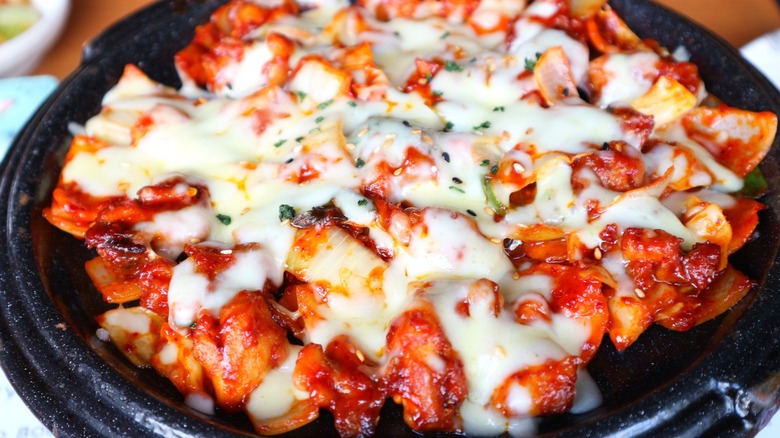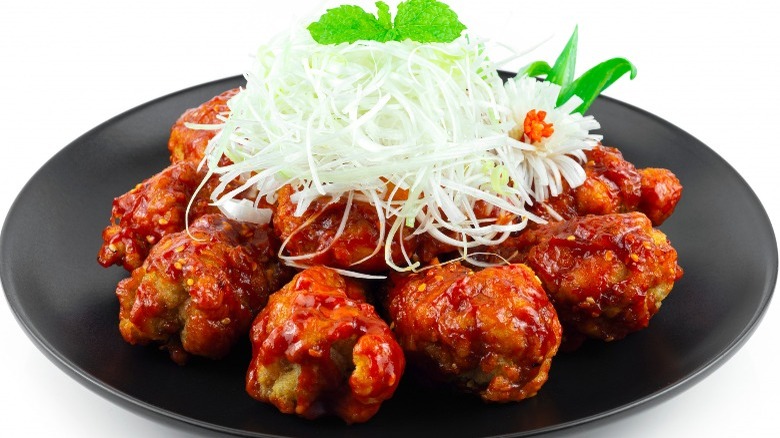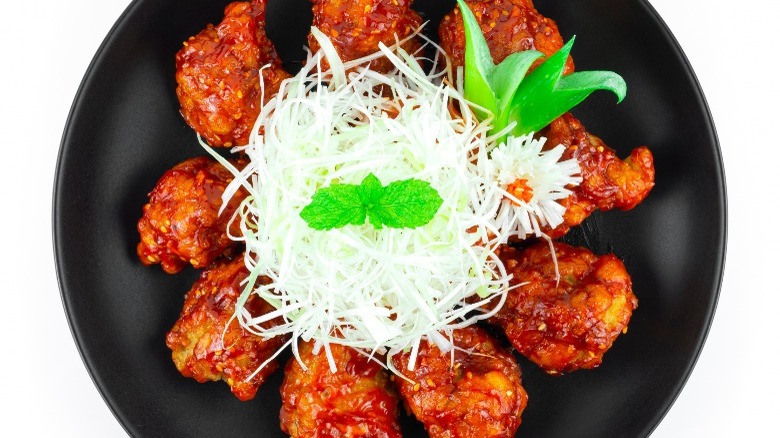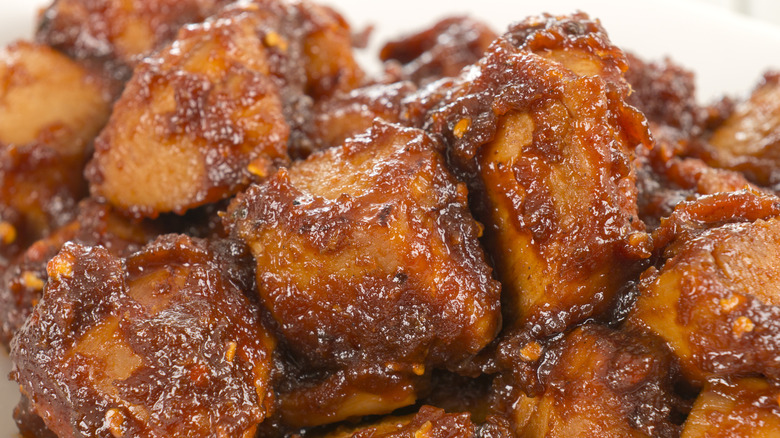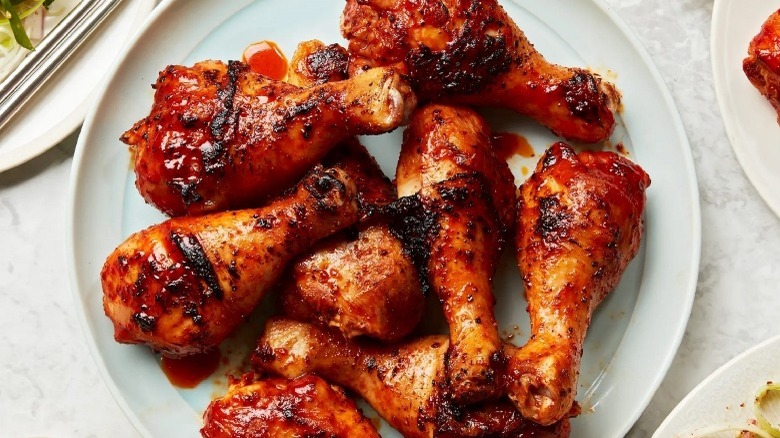Buldak: The Fiery Korean Chicken Perfect For Game Day
Let's face it; when it comes to game day, not much has changed. While tradition may reign out on the field and in the hearts of face-painting, for jersey-wearing die-hard fans everywhere, things can get, well, a little boring on the game day table. No doubt, many of us look forward to the requisite hedonism of hot wings and pizza, sub sandwiches and sliders, chips and dip, fiery chili and nachos, and those weirdly addictive mini meatballs slathered in their saccharine sweet congealed barbecue and grape jelly sauce (as noted by The Pioneer Woman).
But you're a beast. You're not content to settle on the sidelines, are you? Making the same play year after year? Don't you want your shot? You can't languish here on the bench. No, not you — you're a star. You've got a new play up your sleeve, the stuff of a legend. Now's your chance, kid; gotta make your mark. Tell 'em, "C'mon, coach, put me in!" Let's show 'em what you got — and what you got is buldak.
What is buldak?
If you love game day food and you want to bring the fire to your feast, look no further than buldak. It's got all the winning elements: heat, sweet, cheese, and sauce. Translated from Korean, where "bul" means fire and "dak" means chicken, buldak literally means "fire chicken" (via Maangchi). In fact, CNN Go Reporter Rob McGovern once described the dish as a "violent torrent of invisible fire" (via CNNGo). Now, who doesn't want to sign up for that?
So, what exactly is buldak? It's a spicy marinated chicken (usually thighs), fire-grilled, topped with cheese (typically mozzarella), and then popped under the broiler until melty and browned. The dish's heat is derived from the soaked-in and fire-grilled-on flavor of its fiery marinade, made by layering the funky, sweet, fermented heat of gochujang paste with the dry, powdered, smokey flames of gochugaru chili powder in a mix of garlic, ginger, black pepper, soy sauce, and rice syrup (you can sub corn syrup, honey, or sugar). The results are epically fiery and mouthwateringly (as well as eye-wateringly) crave-worthy.
The history of buldak
The history of Korean fire chicken is not all that long. While its true beginnings date back to 2001, it purportedly did not take off until 2003's financial recession (via The New York Times), when an uptick in spicy food consumption reportedly helped keep trend-watching Korean restaurants in business. The rise in popularity of these spicy offerings has been attributed to consumers seeking comfort from their recession woes in the arms of scorching hot endorphin-inducing dishes like Korean fried chicken, tteokbokki, sotteok sotteok, nakji-bokkeum (spicy octopus stir fry), and red ramen (via CNN).
While there was some dispute over who owned the rights to the dish's name, the term has been decided as "common use" by the court in 2008 (via Kajomag). The creator of buldak's heat layering sauce is said to be Hong Seong-pyo, President of Hongcho Buldak (a popular restaurant chain), who was inspired while studying abroad in Japan to recreate a sauce based on something he tasted there.
After opening and failing in his first attempt, Hong Seong-pyo continued working on perfecting his sauce and reopened the Hongcho Buldak (which translates to "red pepper fire chicken") restaurant in Sinchon in September 2002. However, it wasn't until the opening of his third location in 2003 that the dish really took off, setting off a chain reaction that saw Hongcho Buldak open over 100 new locations that year and the rapid rise of imitators before spreading the gospel of buldak worldwide (via Korean newspaper Munhwa).
What you need to make it
The key to buldak is the sauce. Since Hongcho Buldak's sauce is top secret (it's said that the only person who knows the full recipe is Hong Seong-pyo himself), there are plenty of takes on this popular fiery sauce. In fact, besides the variety of buldak shops throughout Korea, the dish's popularity reached a fever pitch with the release of buldak ramen noodle flavors and the viral "Fire Noodle Challenge" they inspired (via America's Test Kitchen). What all buldak sauces seem to have in common is soy sauce, some kind of sugar (traditionally rice syrup though some even use Sprite, Serious Eats notes), fresh ground black pepper, garlic, ginger, water or chicken broth, and the stars of the show — gochujang paste (Korean red chili paste) and gochugaru (Korean chili powder). The rest of the dish is up to you.
While some of the most popular versions see chicken thighs bathed in heat and covered in cheese, there are choices to be made, Maangchi says. If you're lactose intolerant or otherwise averse to cheese, you can skip it, focusing on the saucy goodness of your buldak. If you're vegetarian or vegan (provided you skip the cheese), you can substitute tofu, seitan, or mushrooms for chicken. In terms of chicken, while the dark meat of thighs is superior at retaining the chicken's moisture, bone-in options like chicken legs and wings bring a depth of flavor and finger-licking portability that you can't beat on game day.
How to make buldak
Once you've selected your chicken and whipped up the sauce, it's time to let your meat soak up the heat (reserving half of your sauce) for about an hour before firing up the grill (or your grill pan, as the case may be) and searing up a little charcoal on those babies, says Serious Eats. If you're omitting the cheese — you're done (save a little more sauce before serving for layering). But if you're all in and you've decided to go for the full decadence of hot melty and stringy cheese, now is your time to shine.
After letting your chicken thighs rest a few minutes to retain their juices, cut them up into bite-sized pieces and put them into an oven-safe pan (cast iron is a great choice to impart a little more smokey flavor), then cover the chicken with the reserved sauce, top with mozzarella and put it under the broiler until the cheese is golden brown, bubbly, and melted. Next, sprinkle with freshly chopped green onion and/or sesame seeds and wait to be declared MVP.
